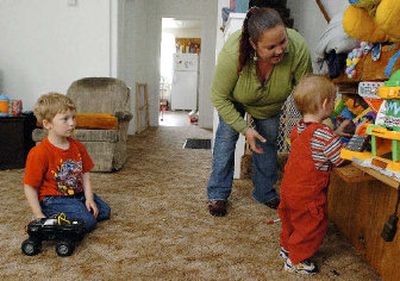Inflation hits home

CHICAGO — Wall Street is worried about inflation. So are Amy Lopez of Eureka, Calif., Sharon Connlley of Duluth, Minn., and Elmer Hunt Jr. of Boise, Idaho.
They and other Americans are increasingly feeling the squeeze of higher prices, not only at the gas pump but in the cost of groceries, delivery charges, travel and numerous other items.
Inflation remains modest by historical standards at about 3.5 percent. It appears no threat to return any time soon to the double-digit rates of the late 1970s and early ‘80s, perhaps not even to the 5 percent level last seen in the spring of 1991.
But driven by soaring energy prices, inflation is creeping toward 4 percent for the second quarter and is on pace for the highest annual rate in 15 years.
A government report Tuesday showed that prices paid by producers rose 5.6 percent for the previous 12 months, thanks to the relentless rise in energy prices. Economists are forecasting that another report due on Wednesday will show that consumer prices also kept rising.
While those rates may seem tame, the steady increase has caused so much concern that Federal Reserve Chairman Ben Bernanke is threatening to extend the Fed’s two-year rate-raising campaign, sending the stock market plunging this month.
Inflation remains “an annoyance” at the moment for most consumers, according to Carl Tannenbaum, chief economist for LaSalle Bank in Chicago.
“Certainly some of these rising prices have hurt people who live on more modest incomes,” he said. “But in general, these rises in prices have not crippled households at all.”
Still, many are growing uncomfortable with each tick higher in rates, as balancing checkbooks gets more difficult.
“The majority of households are feeling a little uneasy,” said Diane Swonk, chief economist at Mesirow Financial, a Chicago-based financial services firm. “They haven’t lost a job but they haven’t gotten any pay increases to compensate for the higher gas prices, higher prices elsewhere. You have a prolonged period where people … are feeling like their living standards aren’t doing as well.”
While wealthier households may be absorbing the price shocks painlessly, that’s hardly the case at the other end of the wage spectrum, where millions of Americans don’t need to check stock portfolios to feel the impact. Especially among lower-income workers, inflation is forcing more and more sacrifices, compromises and budget-juggling.
For Amy and Jacob Lopez, the $70 cost of filling up their Ford mini-van has made it tough to get by every month and may force them to sell their car for a cheaper one. But that’s just the tip of inflation’s impact on the northern California couple and their two preschool-age children.
Amy, a stay-at-home mom, cited the effects of higher prices for everything from rent to utilities to grocery items from milk to hamburger meat. Meanwhile, wages for her husband, who works in inventory at a flower bulb farm, have stayed the same.
“We have had to cut quite a lot of things out” to make ends meet, such as weekend outings, buying treats for their kids and visiting their grandparents, the 23-year-old said.
With rent now accounting for more than half their monthly income of $1,200, they had to seek help from a local food bank recently. Trying to stretch every dollar, they’ve switched to cheaper brands of shampoo and soap. Lopez isn’t sure what steps to take next.
“I just think the cost of living everywhere is going up, and wages aren’t,” she said. “If food and stuff are constantly going up, I think people should be paid more.”
U.S. wages actually have been roughly keeping pace with inflation for the average American, according to Mark Zandi, chief economist at Moody’s Economy.com in West Chester, Pa. But the recent trend means they likely won’t be in the future, he said.
Lower-paying jobs also are more vulnerable to price rises and perhaps less likely to keep pace.
In Duluth, the 48-year-old Connlley, who makes $9 an hour as a receptionist, is buying more noodles, lower-quality meats and more canned vegetables instead of fresh ones to try to cope.
Not only does she feel inflation’s pinch on her own lifestyle, she sees the consequences on others in her job at a low-income affordable housing organization in the northern Minnesota city. Some 28,000 people in a population of 86,000 are under the poverty line there, according to Sonia Bonilla of the nonprofit group Community Action Duluth.
“Every day I see people making other choices” because of the costs crunch, Connlley said. “To eat healthy is way more expensive than to eat mac and cheese.”